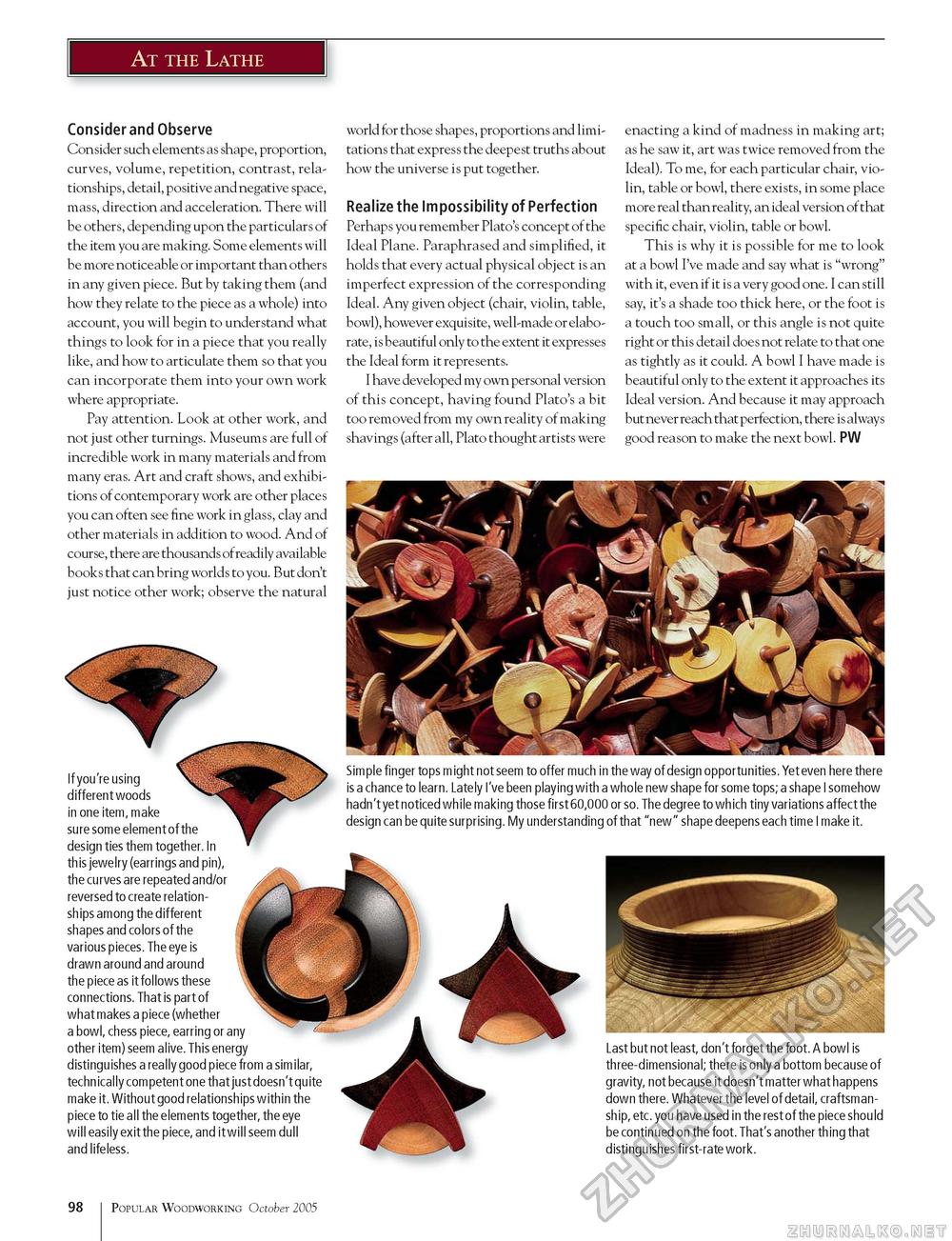Popular Woodworking 2005-10 № 150, страница 102
At the Lathe Consider and Observe Consider such elements as shape, proportion, curves, volume, repetition, contrast, relationships, detail, positive and negative space, mass, direction and acceleration. There will be others, depending upon the particulars of the item you are making. Some elements will be more noticeable or important than others in any given piece. But by taking them (and how they relate to the piece as a whole) into account, you will begin to understand what things to look for in a piece that you really like, and how to articulate them so that you can incorporate them into your own work where appropriate. Pay attention. Look at other work, and not just other turnings. Museums are full of incredible work in many materials and from many eras. Art and craft shows, and exhibitions of contemporary work are other places you can often see fine work in glass, clay and other materials in addition to wood. And of course, there are thousands of readily available books that can bring worlds to you. But don't just notice other work; observe the natural If you're using different woods in one item, make sure some element of the design ties them together. In this jewelry (earrings and pin), the curves are repeated and/or reversed to create relationships among the different shapes and colors of the various pieces. The eye is drawn around and around the piece as it follows these connections. That is part of what makes a piece (whether a bowl, chess piece, earring or any other item) seem alive. This energy distinguishes a really good piece from a similar, technically competent one that just doesn't quite make it. Without good relationships within the piece to tie all the elements together, the eye will easily exit the piece, and it will seem dull and lifeless. world for those shapes, proportions and limitations that express the deepest truths about how the universe is put together. Realize the Impossibility of Perfection Perhaps you remember Plato's concept of the Ideal Plane. Paraphrased and simplified, it holds that every actual physical object is an imperfect expression of the corresponding Ideal. Any given object (chair, violin, table, bowl), however exquisite, well-made or elaborate, is beautiful only to the extent it expresses the Ideal form it represents. I have developed my own personal version of this concept, having found Plato's a bit too removed from my own reality of making shavings (after all, Plato thought artists were enacting a kind of madness in making art; as he saw it, art was twice removed from the Ideal). To me, for each particular chair, violin, table or bowl, there exists, in some place more real than reality, an ideal version of that specific chair, violin, table or bowl. This is why it is possible for me to look at a bowl I've made and say what is "wrong" with it, even if it is a very good one. I can still say, it's a shade too thick here, or the foot is a touch too small, or this angle is not quite right or this detail does not relate to that one as tightly as it could. A bowl I have made is beautiful only to the extent it approaches its Ideal version. And because it may approach but never reach that perfection, there is always good reason to make the next bowl. PW Simple finger tops m ight not seem to offer much in the way of design opportunities. Yet even here there is a chance to learn. Lately I've been playing with a whole new shape for some tops; a shape I somehow hadn't yet noticed while making those first 60,000 or so. The degree to which tiny variations affect the design can be quite surprising. My understanding of that "new" shape deepens each time I make it. Last but not least, don't forget the foot. A bowl is three-dimensional; there is only a bottom because of gravity, not because it doesn't matter what happens down there. Whatever the level of detail, craftsmanship, etc. you have used in the rest of the piece should be continued on the foot. That's another thing that distinguishes first-rate work. 98 Popular Woodworking October 2005 |








